Fire and Problems During Testing
July 13, 2013 -- Steam pipe ruptures and a small fire occurred during testing of solar power towers in Ivanpah Valley in May.
See ReWire at KCET - http://www.kcet.org/news/rewire/solar/concentrating-solar/pipeline-rupture-fires-vex-ivanpah-solar-crews.html
More Power Tower Testing Photos
June 2013 >>here.
Testing the Towers
May 15, 2013 - The photo shows one of the power towers turned on for testing. Mirrors focus on the receiver on top of the tower, although this photos shows that possibly not all mirrors are turned to aim exactly at the tower, but some focus reflected sunlight next to the tower in "stand by" positions.
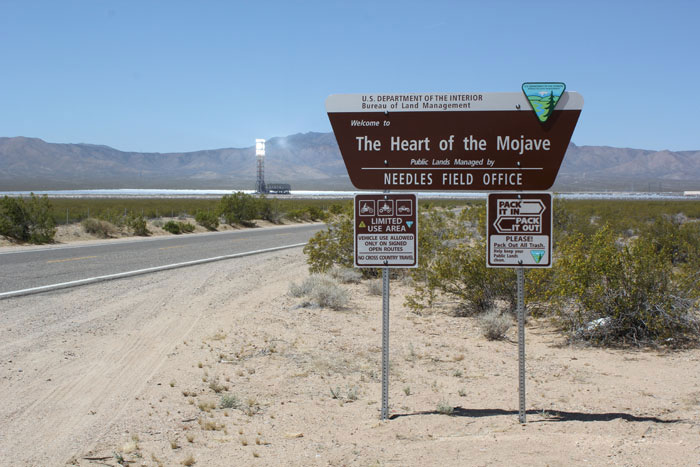
BrightSource Seeks Mitigation Bank
November 28, 2012 - BrightSource Energy petitioned the California Energy Commission this month to seek use of the state mitigation program set up in 2010 to be able to mitigate the ephemeral wash habitat that was impacted by the Ivanpah project. California Senate Bill 34, the "Padilla Bill", was signed into law March 22, 2012 by then-Governor Schwarzenegger with Interior Secretary Salazar present at the Harper Lake Solar Electric Generating System.
It established a Renewable Energy Resources Development Mitigation Trust Fund where a solar company can simply write a check and think no more about mitigation. Then California Department of Fish and Game (DFG) uses the fund to purchase private land at their discretion. In this case it is the ephemeral wash habitat in Ivanpah Valley destroyed by the project which must be mitigated by buying and protecting 175 acres of compensatory wash habitat. Of course we were all hoping it would be in Ivanpah Valley, but the bill makes clear DFG can buy land anywhere in the California Desert Protection Act area, and most likely will purchase scraps of small private inholdings in west Mojave Desert Desert Wildlife Management Areas and Wilderness Areas.
This wash habitat in Ivanpah Valley is important desert tortoise habitat as well, so tortoises were supposed to benefit, but now it is clear that Ivanpah tortoises (genetically distinct from West Mojave tortoises) will not benefit from any more wash habitat protected. Washes are important to conserve because of higher vegetation density, bird use, and tortoises often find increased forage as well burrow sites in wash walls.
Our problem has always been: Ivanpah tortoises are not benefitting from mitigation using the SB 34 state mitigation bank; the public is cut out of the loop in being able to review this mitigation, since it takes place after approval and by state agencies that will make the decisions without review. This is mitigation abstracted from the locally impacted ecosystem.
The bill states only certain solar thermal projects qualify, those that received stimulus funding and Department of Energy loan guarantees.
Video on Tortoises, Ivanpah Valley, and Solar in the Desert
January 31, 2012 - Reporter Judy Muller covered the story "The Great Green Rush: Desert Solar Energy Leaving Tortoise in the Dust?" for SoCal Connected which aired on KCET on January 20. The video was produced by Karen Foshay. Dr. Michael Conner of Western Watersheds Project was interviewed about the plight of the Desert tortoise, and he did an excellent job.
The only error is the reporter stated that Ivanpah Valley is a solar energy zone, but Bureau of Land Management has only included this valley in the zoning process undertaken in the Solar Programmatic Environmental Impact Statement as "Variance" areas. It is not a Solar Energy Zone, but proposed for a Variance area outside the Zones that would still be open to solar development with a higher bar of application requirements. We recommend the alternative that excludes Ivanpah Valley from all solar development to allow for connectivity of tortoises across populations in the region.
Video Here:
http://www.kcet.org/shows/socal_connected/content/environment/desert-tortoise.html
Program note:
End of August Construction Photos
September 8, 2011 - Ivanpah Valley, California.
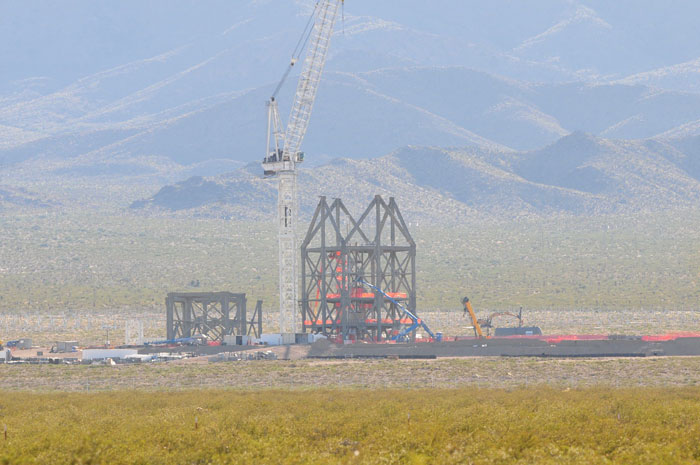
^Unit 1 power tower goes up.

^Construction layout area.
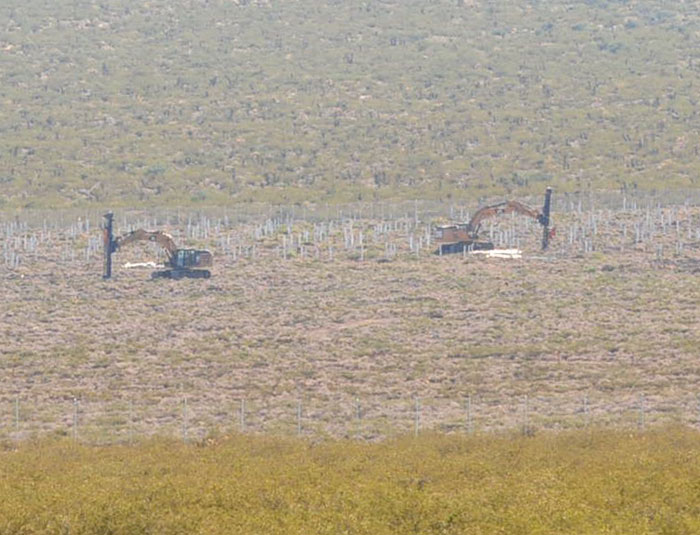
^Pole drivers place poles to support the mirrors, Unit 1.
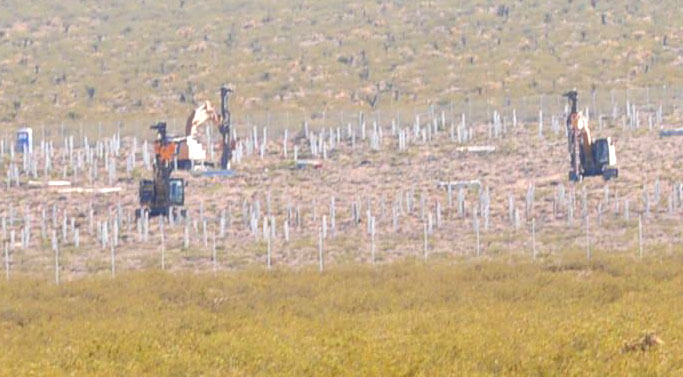
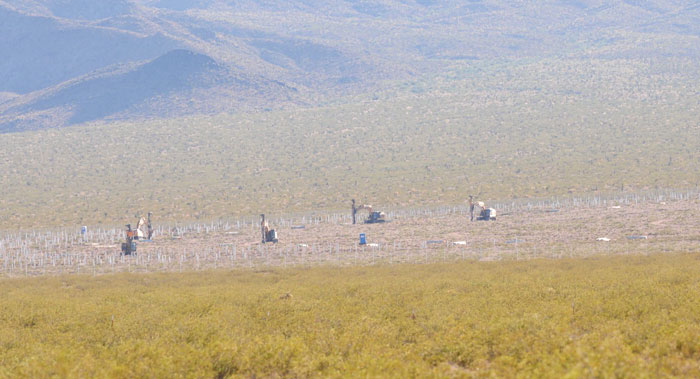
^Unit 1 heliostat field.
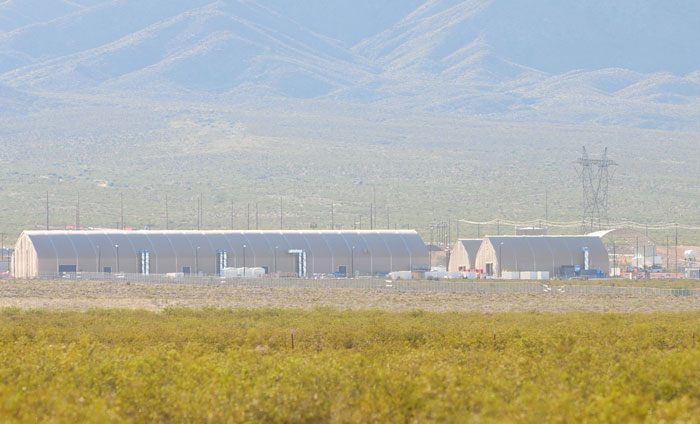
^Temporary buildings in the construction laydown area.
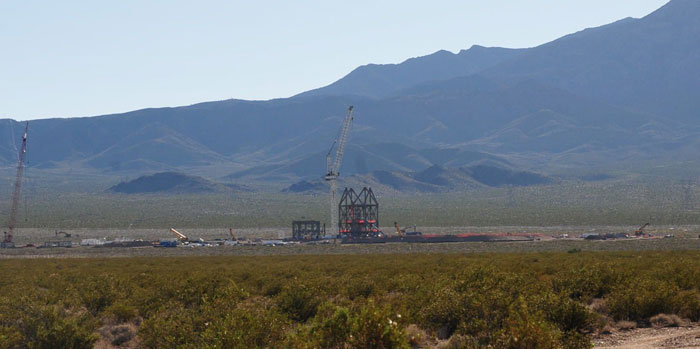
^Unit 1.
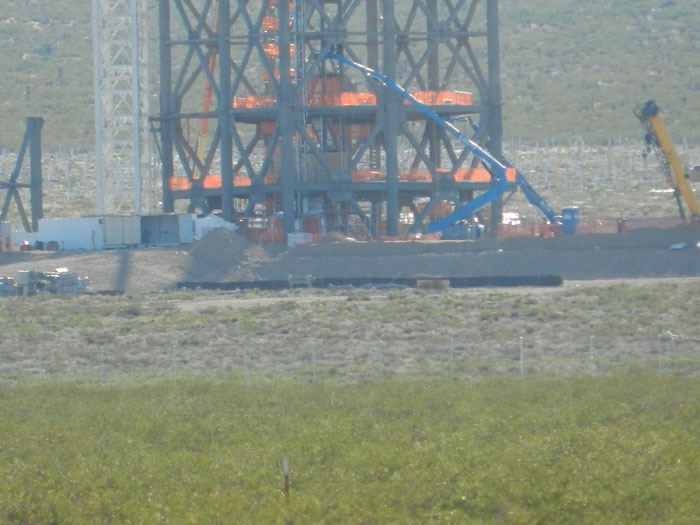
^Power tower. The creosote has been trimmed, but due to recent heavy summer rains, notice how green leafy stump-sprouting shrubs may be regrowing.
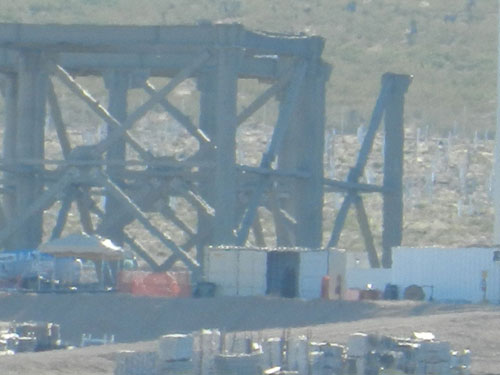
^Unit 1 power tower base.

^Unit 2 under construction.
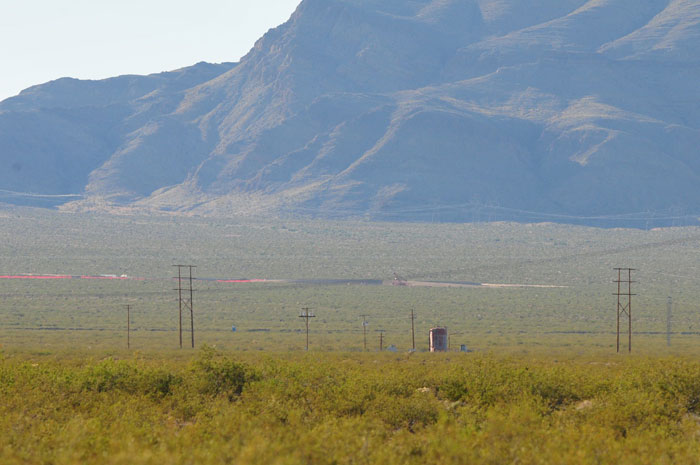
^Unit 3 powerblock is graded.
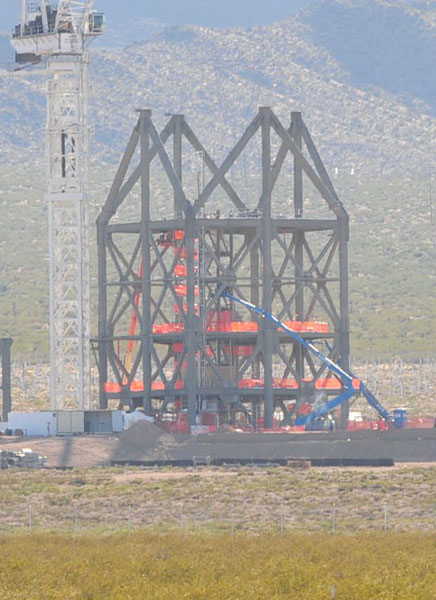
^Unit 1 power tower under construction.
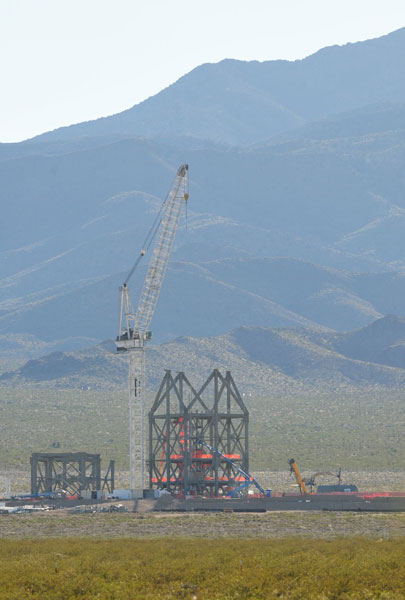
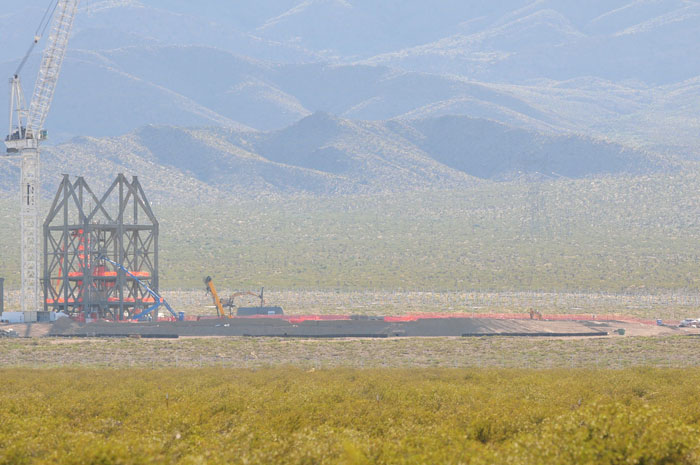
^Unit 1 powerblock area.
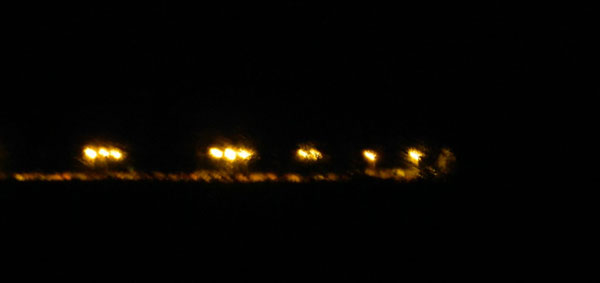
^From the freeway exit, at night the construction laydown area forms a small new city in the desert.
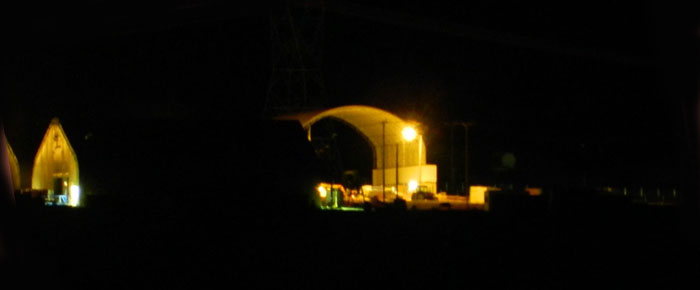
^Telephoto view of the construction laydown area at night.
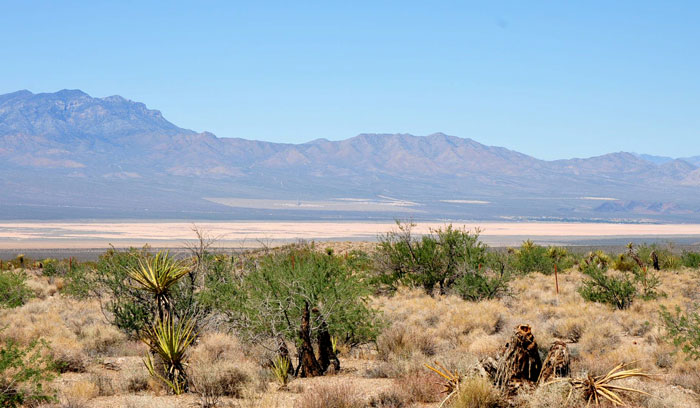
^From the other side of Ivanpah Valley along Nipton Road, the full project can be seen.
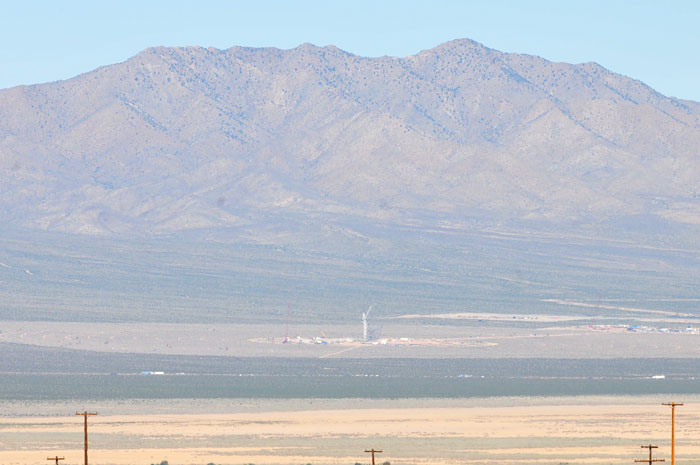
^Unit 1 from Nipton.


^Unit 3 powerblock from Nipton.
Report on Flood Damage
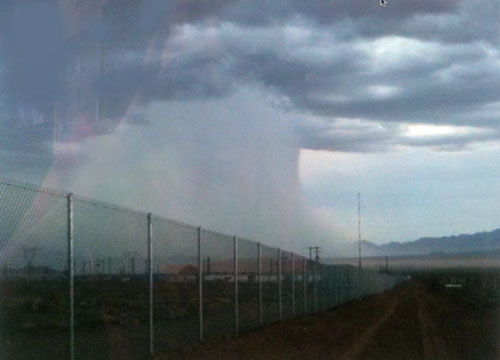
^Cloudburst hits the fan above the solar project in Ivanpah Valley. (Photo from CEC)
August 10, 2011 - At a Sacramento business meeting of the California Energy Commission today, CEC staff gave a report on damage to the Ivanpah Solar Electric Generating System construction site from a summer rain storm that occurred on July 5, as part of compliance monitoring of the project.
All photos are from the public business meeting presentation or from the report at:
http://www.energy.ca.gov/sitingcases/ivanpah/compliance/index.html
A storm cell from monsoonal flow sat over the the project and rained a large amount of moisture, causing flash flooding in the normally dry washes that flow through the site. CEC estimated this was a 15- to 20-year storm event. "It was a lot of water," the CEC staff member told the Commissioners. Lightning strikes hit the area, and power to the project site was knocked out temporarily.
The fabrication building and parking lots in the Common Area became flooded and were the most damaged, as they had been graded flat and were more disturbed than other areas.
Silt fences used around many perimeter fences apparently caused pooling of flood waters, and CEC recommended they be used with care in the future.
A diversion berm was unfinished so caused problems by shunting the flood directly into the Common Area. BrightSource's Stormwater Management Plan was not yet fully in place.
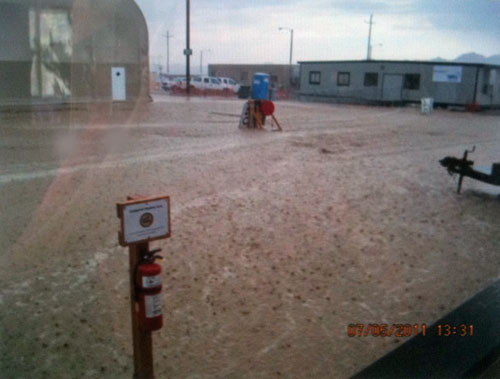
^Floodwaters collect in the graded Common Area. (Photo by CEC)
The Tortoise exclusion fence at Unit 2 failed as floods took the fence down. CEC staff said there were apparently no desert tortoises on either side of the fence. The flood collected a lot of vegetation, which built up against the fence, damaging it. Other fencelines had scour along them. BrightSource needed about two weeks to clean up. Construction was delayed.
The tortoise pens had surface flow through the area, but only minor erosional damage. Many tortoises came out of their burrows, and two new burrows were found as the reptiles apparently dug into the soft ground.
There was not much erosion, according to CEC, in the heliostat field. Some poles had erosion, "but not much."
CEC said this is a "dynamic environment, and intermittent and dynamic environment."

^Flood runoff. (Photo by CEC)

^Tortoise fence damage. (Photo by CEC)
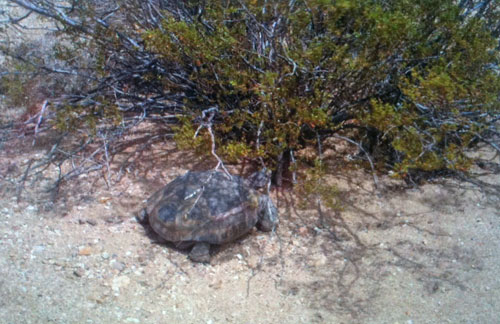
^Desert tortoise. (Photo by CEC)
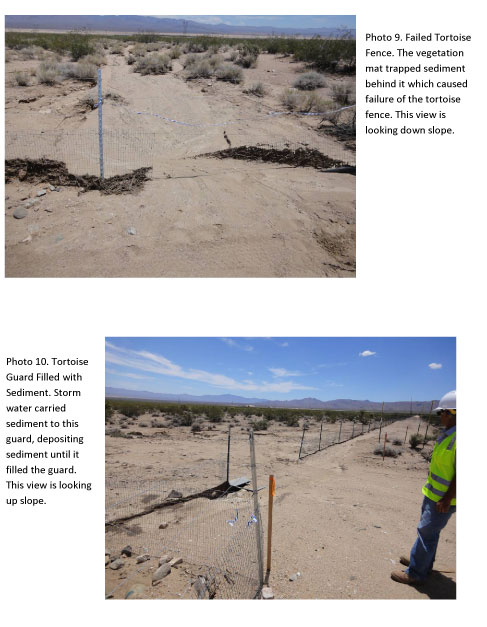
^Photos of tortoise fence damage from the flood. (Photo by CEC)

^Path of flood around berm. (Photo by CEC)

^Erosion in heliostat field. (Photo by CEC)

^Map showing locations of flood damage photos in CEC compliance report.
Governor Brown Files Brief in Western Watersheds Project Lawsuit

July 22, 2011 - Sacramento, CA - California Governor Jerry Brown filed a brief asking a federal court to deny a request by the environmental group Western Watersheds Project for an injunction to stop the Ivanpah Solar Electric Generating System currently under construction.
Western Watersheds Project launched its effort to halt the project in January 2011 against the Department of the Interior, the Bureau of Land Management, and the U.S. Fish and Wildlife Service. Three weeks ago, a federal judge denied the environmental group's application for a temporary restraining order against the project.
The environmental group is continuing to pursue a preliminary injunction to halt the project,in eastern California near the Nevada border. The project site consists of 5.4 square miles of high quality habitat for the threatened desert tortoise.
"No project can be considered clean or green when it involves destruction of habitat for a species listed under Endangered Species Act on this scale," said Michael Connor, California director for Western Watersheds Project.
"The Department of Interior is tasked with siting energy projects in an environmentally sound manner," said Connor. "Instead it is allowing thousands of acres of important desert tortoise habitat to be bulldozed when there are alternative ways of generating power."
Threatened by habitat loss, habitat degradation, disease, and predation by ravens and coyotes, the Mojave population of the desert tortoise was listed as threatened under the Endangered Species Act in 1990. Populations continue to decline.
"The environmental review for this project was rushed and inadequate - the agencies did not even determine how many desert tortoises were on the site, nor did they determine what impact blocking the north Ivanpah Valley with an industrial-scale power plant would have on connectivity with other tortoise populations," said Connor.
Since then, the Mojave population has been determined to be a separate species from desert tortoises in Arizona and Sonora, Mexico. The unique genetics of the Mojave tortoise, and especially that in Ivanpah Valley, is under more threat of exticntion than ever now. Cumulative energy project impacts on the tortoise populations in these valleys was not adequately considered.
"California has set a bold course for its march toward reliance on renewable energy and the Ivanpah project is a very important step in this effort," the state's brief reads.
"California has a strong and demonstrated interest in increasing its renewable energy and decreasing greenhouse gas emissions," argues the brief. "The Court should take these interests into account, and deny Western Watersheds' request for a preliminary injunction on the grounds that an injunction is not in the public interest."
http://www.ens-newswire.com/ens/jul2011/2011-07-22-091.html
Construction Halt Lifted, New Tortoise Rules Issued
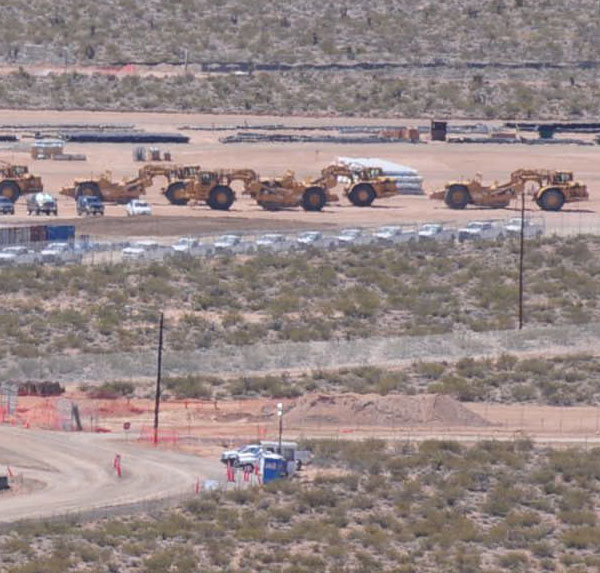
June 14, 2011 - The awaited Revised Biological Opinion was issued June 10 by US Fish and Wildlife Service (FWS), describing detailed new rules that allow the Ivanpah Solar Electric Generating System to resume construction activities. FWS reveiwed the latest tortoise numbers, much higher than expected, but still decided that no significant impacts would endanger the local tortoise population.
An immediate temporary suspension of activities decision was issued April 15 and has now been lifted since the U.S. Fish and Wildlife Service issued a new Biological Opinion concluding the project will not jeopardize the threatened desert tortoise.
The Bureau of Land Management (BLM) lifted its suspension of construction activites on Units 2 and 3 (work had been allowed to continue on Unit 1 since it had been already cleared of tortoises). BrightSource, the solar company building the massive power plant, will be allaowed to fence of the remaining project and work on the power block of Unit 2. Furhter removal of tortoises in the large solar field areas, currently still Mojave Desert Scrub, will be allaowed this fall when air temperatures decrease to below 95 degrees Fahrenheit (a threshold when tortoises may be safely moved and not overheat).
According to a BLM press release, BLM reinitiated consultation with the FWS in March after the project proponent BrightSource Energy reported finding more tortoise in the project area than originally anticipated. The BLM issued an Immediate Temporary Suspension of Activities decision for the project in April when project biologists reported reaching the limit of number of tortoises handled under the original Biological Opinion.
After reviewing the new information and clearance data at the project site, the FWS issued a new Biological Opinion today that includes new stipulations for translocating tortoise as well as new requirements for protecting them from predators and increased monitoring and fencing.
“This new Biological Opinion allows the project to move forward without jeopardizing the tortoise, taking into account the higher number of animals found,” said BLM-California Acting State Director Peter Ditton. “We worked closely with the Fish and Wildlife Service throughout the development of this new BO and will continue to work together to monitor
construction of the ISEGS project.”
The BLM issued a Notice to Resume Activities and Notice to Proceed on Units 2 and 3 today, giving BrightSource the green light to resume construction with the new stipulations and requirements for protecting tortoise. Approved construction will include the power block in Unit 2 and the Unit 3 access road. Work on the heliostat fields in Units 2 and 3 will
not move forward until the tortoise translocation window reopens in the fall when the weather cools. The new Biological Opinion and Notice have been posted on the BLM website at http: http://www.blm.gov/ca/st/en/prog/energy/fasttrack/ivanpahsolar/fedstatus.html
See also the Riverside Press-Enterprise:
http://www.pe.com/localnews/stories/PE_News_Local_D_tortoises11.38e3062.html
